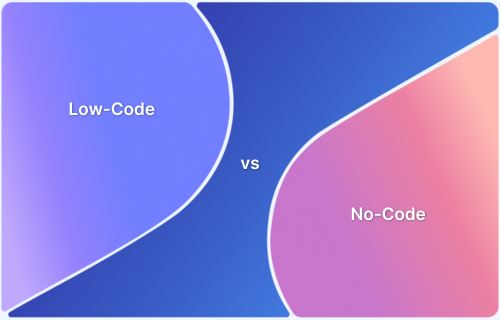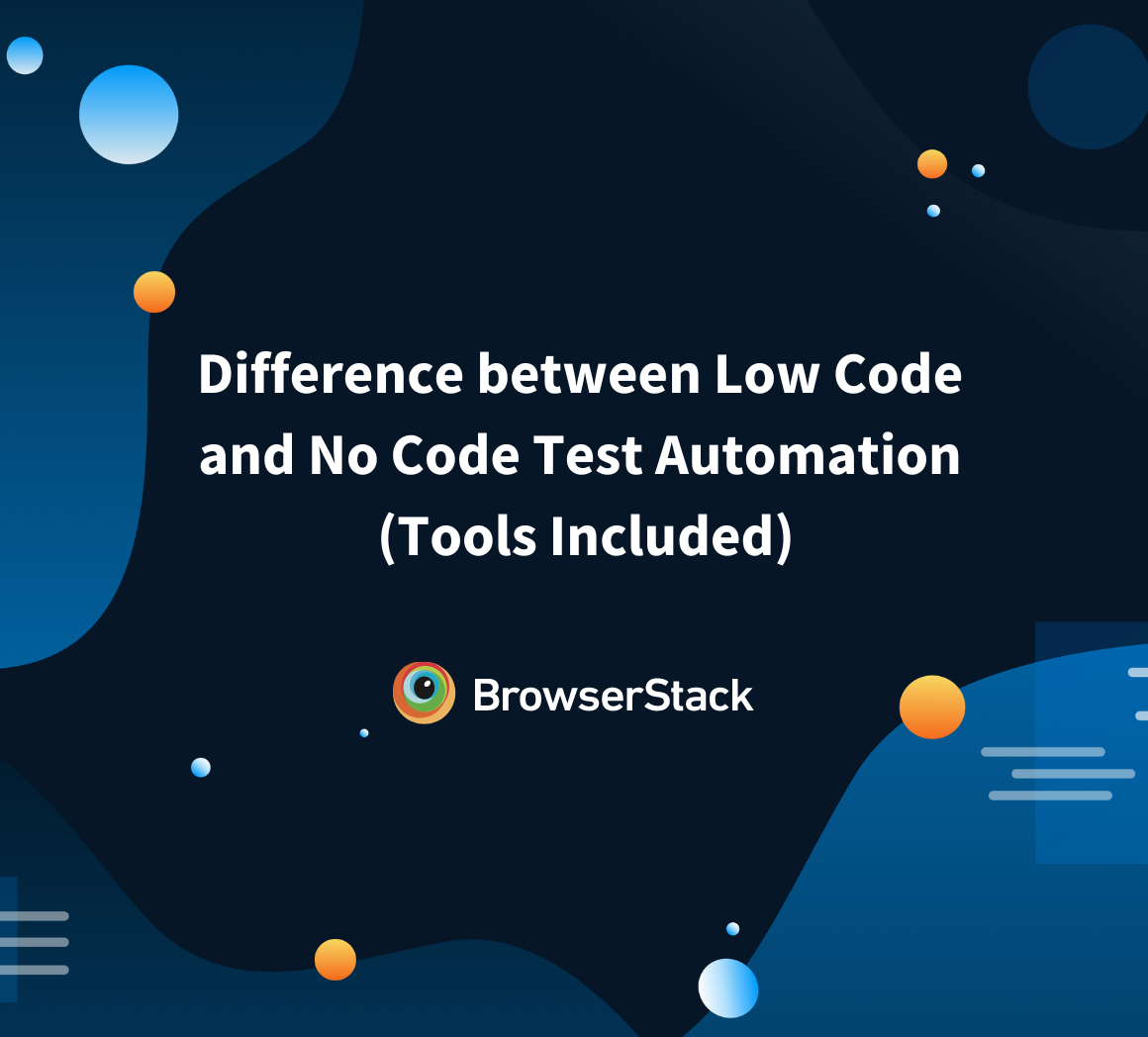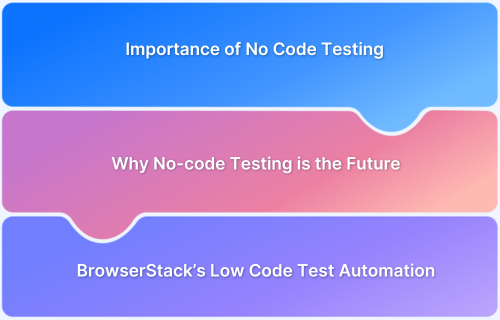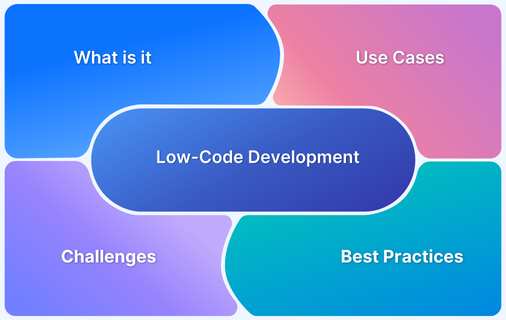Low-code and no-code platforms make development easier by reducing or removing the need for coding.
Overview
Low-code helps developers create advanced applications with minimal coding, while no-code allows users to build applications using visual tools. Both options speed up development and improve efficiency, reducing dependence on traditional coding.
Key Differences:
- Coding Requirement: Low-code requires minimal coding, while no-code requires none.
- Flexibility: Low-code offers customization, whereas no-code is limited to predefined functions.
- Target Users: Low-code suits developers, whereas no-code is for non-technical users.
- Use Cases: Low-code for complex applications, while no-code for simple workflows.
- Scalability: Low Code supports enterprise apps, whereas no-code is best for small-scale projects.
Knowing the differences between low-code and no-code helps teams pick the right platform. The choice depends on technical needs and business goals.
This article breaks down Low Code vs No Code, their differences, benefits, use cases, and how they compare to traditional automation. It also covers choosing the right approach for development and testing
What is Low-Code?
Low-code is a software development method that allows users to develop applications with minimal coding and technical expertise. It uses visual interfaces, drag-and-drop features, and pre-built templates to accelerate application development.
Low-code platforms empower professional developers and business users to build and test applications without deep programming knowledge.
The core concept of low-code is to simplify the development and testing process by reducing the complexity and time typically required for traditional coding. Low-code platforms simplify application creation by abstracting code and providing visual tools for designing interfaces, workflows, and data models.
Read More: Comprehensive Guide to Low-Code Development
Examples of Low-Code Development Platforms:
- OutSystems: A powerful platform for quickly building web and mobile applications with full-stack development tools.
- Mendix: A cloud-based platform enabling rapid app development, integration, and collaboration for both business users and developers.
- Appian: A low-code platform focused on process automation, allowing users to build apps, automate workflows, and integrate systems with minimal coding.
What is No-Code?
No-code code is an approach that allows users to create and test applications without writing any code.
No-code platforms enable users, often business professionals or citizen developers, to build fully functional applications without needing programming skills by using visual interfaces, drag-and-drop components, and pre-built templates.
Unlike low-code platforms, which may still require some coding for complex features, no-code platforms are designed to be entirely code-free, making them accessible to non-technical users.
Read More: Why is no-code the future of testing?
Examples of No-Code Platforms
- Webflow: A no-code platform for building responsive websites with a visual interface. It is ideal for users with no programming experience.
- Bubble: Allows users to create fully interactive web applications through a drag-and-drop interface without writing code.
- Adalo: Provides an intuitive drag-and-drop interface for designing and deploying mobile apps for Android and iOS.
Pros and Cons of Low-Code/No-Code Development Platforms
Low-code and no-code platforms offer significant advantages, but they also come with limitations that businesses should consider when deciding whether to use them for application development
Pros of low-code/no-code development platforms:
- Faster Development: These platforms allow users to build and deploy applications faster than traditional coding methods, speeding up the development process.
- Empower Citizen Developers: Non-technical users can create and customize applications, decreasing reliance on IT departments and fostering innovation within business teams.
- Cost Efficiency: These platforms minimize the dependency on expensive developers by reducing the need for extensive coding skills, which helps lower overall project costs.
- User-Friendly Interfaces: With visual tools, drag-and-drop components, and pre-built templates, these platforms make it easy for users with limited technical expertise to create fully functional applications.
- Flexibility: These platforms provide varying levels of flexibility, enabling users to build solutions that can be customized to meet business needs and workflows.
Cons of low-code/no-code development platforms:
- Limited Customization: Low-code and no-code platforms may not support highly complex logic, custom features, or specialized applications that require advanced coding skills.
- Scalability Challenges: These platforms may face difficulties in handling large-scale applications or systems that need advanced scalability, especially when dealing with high user traffic or large amounts of data.
- Vendor Lock-In: Applications created on low-code or no-code platforms may become tightly integrated with that platform’s ecosystem, which makes it difficult to migrate to other platforms or scale independently.
- Performance Limitations: While suitable for simpler applications, low-code and no-code platforms may struggle with resource-intensive tasks. They may not be suitable for high-performance requirements, which could lead to performance issues in complex or large-scale systems.
Read More: 15 Open source Low Code Testing Tools
How is Low-code and No-code different from Traditional Automation?
Low-code, no-code, and traditional automation differ significantly in their approach, complexity, and accessibility:
Development Approach:
- Low-Code/No-Code: These platforms use pre-built components and visual interfaces, allowing users to drag and drop elements to build applications or workflows. Minimal coding is required, making them accessible to both technical and non-technical users.
- Traditional Automation: Traditional automation relies heavily on coding, requiring skilled developers to write scripts or use specialized tools to automate processes, which demands more technical expertise.
Complexity and Flexibility:
- Low-Code/No-Code: These platforms are designed to simplify development and automate tasks with less customization. While they provide flexibility, they may not support the complex workflows or custom logic required for more intricate processes.
- Traditional Automation: Traditional automation offers more flexibility and customization, allowing developers to create highly complex automation scripts tailored to specific needs. However, it comes at the cost of higher complexity and longer development time.
User Accessibility:
- Low-Code/No-Code: They empower non-technical users to build applications and automate workflows without needing coding skills, making them accessible to a wide range of users within an organization.
- Traditional Automation: This typically requires technical expertise and is usually performed by experienced developers or engineers, limiting its accessibility to a smaller pool of users.
Speed of Development:
- Low-Code/No-Code: These platforms accelerate the development process by simplifying tasks and reducing the need for custom coding. Users can quickly create and deploy automation workflows with minimal effort.
- Traditional Automation: It usually takes longer, as it involves coding, testing, and debugging, making the process more time-consuming.
Customization:
- Low-Code/No-Code: While these platforms offer some customization, they may be limited in handling complex automation scenarios that require custom logic or integration with specialized systems.
- Traditional Automation: Customization is more extensive in traditional automation, as developers have full control over the code, allowing for deep integrations and highly tailored solutions.
Difference between Low-code and No-code
The table below shows the difference between Low-Code and No-Code
| Aspect | Low-Code | No-Code |
|---|---|---|
| Target Users | Helps developers streamline the development process by reducing coding effort, enabling focus on more complex tasks. | Designed for business users with little or no coding skills, simplifying automation and app creation. |
| Use Cases | Ideal for applications requiring complex logic, API integrations, and enterprise-level functionality. | Best suited for front-end applications, internal tools, and simple business automation tasks. |
| Speed | Faster than traditional coding but requires some training for effective customization. | Extremely fast, with intuitive drag-and-drop functionality. |
| System Type | Open system, allowing code extensions, custom plugins, and greater flexibility. | Closed system, with limited customization options, relying on templates and built-in tools. |
| End-to-End Development | Full development capabilities, offering a wide range of customization and integration options. | Some platforms may have limited features, especially in areas like back-end customization. |
| Shadow IT Risk | Lower risk as IT teams generally manage security, governance, and compliance. | Higher risk due to non-IT users creating unsecured apps without oversight. |
| Scalability & Architecture | Supports large-scale applications, works across multiple platforms, and offers better customization options. | Limited scalability, best suited for small, standalone applications or internal tools. |
Read More: AI Automation and Testing
Low-Code vs. No-Code: What to Choose for Development?
The right choice depends on project complexity, customization, and scalability. Here’s a comparison to help you determine which platform suits your development needs:
- For Simple Applications: No-code platforms are ideal for quickly building simple apps or automating basic processes with minimal learning. They’re perfect for business users and small, front-end applications.
- For More Complex Applications: Low-code platforms provide more customization, advanced logic, and integrations. They balance simplicity and flexibility, allowing developers to add custom code for complex workflows.
- Skillset Consideration: No-code is best for non-technical teams needing quick prototypes. Low-code is suitable for teams with technical expertise or those requiring custom features.
- Project Scale and Growth: Low-code platforms offer better scalability and integration for larger projects. No-code works well for smaller apps but may struggle with scaling.
Low-Code vs. No-Code: What to Choose for Testing?
The choice between low-code and no-code for testing depends on your project’s complexity and your team’s expertise:
- For Simple Testing: No-code platforms are ideal for basic tests, like UI testing or automating repetitive tasks. These platforms are user-friendly and great for non-technical testers or teams needing quick results.
- For Advanced Testing: Low-code platforms are better suited for complex testing scenarios, such as load testing, performance testing, or testing applications with complex logic and integrations. They provide more flexibility and control, allowing testers to customize scripts and integrate with other testing tools.
- Skillset Consideration: No-code is great for testers with limited technical knowledge, while low-code platforms require more technical expertise but offer greater customization.
- Scalability: Low-code platforms are better for large-scale, enterprise-level testing that requires extensive automation and integration. No-code platforms, while fast and easy to use, may not scale well for more complex or resource-intensive testing.
In short, no-code platforms are best for simple, quick tests, while low-code platforms are ideal for advanced, scalable testing needs.
To ensure seamless test execution, BrowserStack offers a Low-Code Automation platform that reduces coding efforts while maintaining flexibility. It allows users to create and run AI-driven automated tests without coding, ensuring seamless execution on the BrowserStack cloud.
Why Use BrowserStack for Low-Code Automation?
As Low-Code and No-Code development platforms gain popularity, ensuring seamless test automation across multiple devices and browsers becomes crucial.
BrowserStack’s Low-Code Automation platform simplifies test automation by reducing the need for extensive coding while preserving flexibility and control. It enables non-technical users to effortlessly create and execute automated test cases, ensuring seamless testing across applications.
- Easy Test Creation: Users can record tests by interacting with the application. There is no need for deep coding skills, making it useful for both technical and non-technical users.
- Cloud-Based Execution: Teams can run tests on real devices and browsers without setting up infrastructure, removing the hassle of managing in-house infrastructure.
- Smart Wait Times and Auto-Updates: The platform adjusts wait times based on network activity, reducing test failures. It also updates scripts automatically when the application changes.
- Support for Complex Validations: Users can add checks for functionality, UI changes, and visual states. AI-based visual testing detects unexpected UI updates without extra coding.
- AI-Powered Test Maintenance: Self-healing tests adjust to application changes, reducing maintenance efforts.
- CI/CD Integration and Scalability: The platform works with popular CI/CD tools. Teams can automate tests within their development process for faster feedback.
- Built-in Debugging Tools: The platform provides video logs and reports, which make it easier to find and fix test failures.
BrowserStack streamlines testing by minimizing manual effort and ensuring consistent, reliable execution across multiple environments.
Conclusion
Choosing between Low-Code and No-Code development platforms depends on project needs and user expertise. No-code platforms are ideal for business users, enabling quick automation and app development without IT support. However, they may have limitations in customization and scalability.
Low-code platforms, on the other hand, offer greater flexibility. Developers can build complex applications faster while integrating custom features and scaling efficiently. Understanding both options helps teams make the right choice for speed, control, and efficiency.
BrowserStack provides a low-code automation platform to ensure seamless testing. With real device testing, cross-browser compatibility, and seamless CI/CD integrations, BrowserStack helps teams validate applications effortlessly, ensuring development quality, speed, and reliability.





